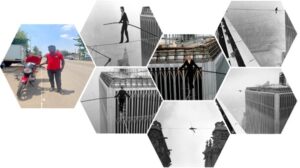Chapter 1
I’ve always wondered about Philippe
I have always wondered about Phillipe Petit. To wake up one day and decide to hang one’s life by the rope… How does one come to this state of mind—and of action?
On the 7th of August, 1974, New Yorkers woke up to find 25-year-old Frenchman Phillipe Petit dangling on a lone rope between the just-erected Twin Towers—over 1,360 feet in the morning air! Imagine the spectacle. The sheer spectacle of it all. First of all, of a human-made building reaching so high up in the air. And secondly, of a man taking a walk between them (those two majestic buildings)—on nothing but a rope. Imagine the splendour!
I have always wondered about Phillipe. How does one get to this state of mind—and of being? To reach such heights—quite literally… To attain the zenith of the human experience and existence… To hang one’s life by a rope… Quite literally, to hang oneself in the balance—to dare to walk on nothing but a rope, across what were then the tallest buildings ever erected in the entire world. Such splendour!

*****
“The Rope Dancer”
He called it a coup—an artistic coup. But look at you and me sitting here in Ghana, a country finding itself on a rocky/thorny path towards national development… You and I here in this country, with just a few decades of tumultuous past behind us—a bloody past of coup d’états… A country finding itself presently flanked by neighbouring coups… We cannot afford to play around with such a word, can we? Not even when employing it as a harmless metaphor. But Phillipe, finding himself in a country finding itself centuries away from its rebellious years, he was able to tiptoe around this metaphor. So, he says, “my artistic coup’ in description of this spectacle he had in-store for those twin towers of the World Trade Centre. He was going to bring the house down—not literally. He was going to tie a rope from one end of the tower to the other end of it, and just walk… Breezily walk… On that lone rope, from one building to the next—over 1,360 feet up in the breezy morning air!
A young magician… A self-trained tightrope walker… Born and bred in the nation of France in the year 1949, the little man Philippe Petit had a knack for scaling things. By the age of 17, he was a working magician with quite the portfolio.
A toothache sent this 17-year-old gentleman to the dentist’s office one day. There, while glancing through a magazine in the waiting room, he stumbled upon an image. There, spread out on a page in that magazine, an artwork of these two buildings. They were to be called the World Trade Centre. The article accompanying this artwork carried an assurance that these wondrous buildings were in fact going to be built one day. Right at the heart of New York, these twin towers were to be erected. Naturally, Philippe knew that on top of these buildings, that was exactly where he was meant to be. Feigning a sneeze, he tore this page out of the magazine as keep-sake, and dashed out of the dental clinic… Still housing a toothache; yet having developed a new ache—a yearning. An excitement! He was going to prepare to walk across these two buildings… Buildings of which hadn’t even been erected yet!
“Normally when people have dreams, they are tangible—the thing is right there, gnawing on you. But the object of my dream hadn’t even been built yet!” He was to say years later. This wasn’t a dream deferred—it was a dream impending.
Perhaps, in anticipation of these buildings—while he waited—he headed for Notre Dame. Right there in his own home nation of France. He clandestinely hung a rope from one end of the Notre Dame buildings to the other—about 200 feet (61 metres) apart and performed this incredible stunt of rope walking, 223 feet (68 metres) in the air. Parisians woke up on the 26th June, 1971 to find 22-year-old Phillipe Petit walking on a rope. An artistic coup—an artistic wonder. One for the world’s record. A showcase of human splendour.
Two years later (in 1973), Petit was to replicate this splendour in Australia, walking the two pylons of the Sydney Harbour Bridge, 292 feet (89 metres) aboveground.
Alas, almost a decade after Phillipe stumbled across this artistic depiction of the impending Twin Towers, these buildings were finally erected. That was around the early 1970s. Naturally, Philippe headed for America—for New York. You can be whatever you want to be in America—so, they say. So, there he was. Accompanied by a handful of friends and accomplices—some coming with him from France, others whom he had met right there in the US.
The buildings were still under construction at the time, but nearing completion. Philippe and his team spent weeks in clandestine preparation—going to the extent of pretending to be journalists sent to report on the buildings; workers sent to work on the buildings; even going so far as to hire helicopters to get an aerial view of the buildings. Where were they going to tie the rope? How were they going to get unimpeded access to the buildings? How were they going to account for the windiness characteristic of such great heights? In a sequence of events mimicking the great heists of the modern world, these young men and lady found their way finally at their top, having worked overnight, and having by only so slim a chance successfully tied their rope. By 7:00 am—on the 7th day of August, 1974—all was set for 25-year-old Philippe to take his first step—this great leap… Into the void—no, onto the void… Onto this otherworldly spectacle. Almost 1,400 feet in the freaking breezy dusky early morning air!
Chapter 2
As I’ve Said Elsewhere…
I don’t know the difference between ‘fear’ and ‘phobia’—I am no psychologist. But I would be lying if I did not admit to myself, this immense and excruciating fear I have for wide-open spaces. I am no Philippe Petit; I cannot stand the void.
Hence, you can imagine the state I was in when on my way from Airport Residential Area to the Accra Digital Centre, my head buried in Google Maps, I found myself, to my dismay, on the Ring Road Central overhead—the one colloquially termed ‘Dubai’ by Ghanaians.
[Note, it is not a fear of driving we’re talking about here, for I learnt how to drive within just a day. It really is, as noted, just a sheer fear of wide-open spaces].
Met with one’s fear, one is easily convinced that death is imminent. I hadn’t budgeted for death that hot afternoon. So immediately, I found an exit, back to the ‘ground’ where humankind belongs. I contemplated returning to the office—my passport renewal could wait. [Please resist the temptation of drawing a link between this sentence and the last discussion you and I had—in the article titled ‘We are Going’].
But upon second thought, I really needed that renewal done. So, I found myself a pedestrian to ask, “How do I get to the Accra Digital Centre without using that overheard?” This gentleman, he begins to give me directions the best way the Ghanaian knows how. “Madam, just go straight. When you reach that billboard, turn left…”
“Wait, which of the billboards?” I asked, shuffling through my bag for my glasses. Looking at my now bespectacled face, he asks, quite shocked, “Oh madam, aren’t you too young to be wearing spectacles?”. “Too much reading.” I explained. We laugh it off—he and I.
I was later told that it was quite dangerous this I did: with a free mind, I said “yes”, when he offered to sit in the car and show me the place. Few minutes later, there I was at my destination. My day, saved by a Good Samaritan. He asks for nothing in return, but one gives him something anyway.
Fellow Ghanaians, the passport process wahala is a whole different story for another day. When I was done with that business at the Accra Digital Centre and was headed back to work, naturally, I avoided ‘Dubai’. I tried other routes, entreating Google Maps to follow my lead instead. Bad idea. Because for some strange reason, I found myself headed for the Accra-Tema Motorway. I’d rather die than use a motorway—much less this infamous one.
Ladies and gentlemen, are we allowed to call this a Mexican standoff? Because sitting in the car, it really did feel like one. There I sat, driving around in circles, hoping Google Maps would suggest something better.
Rerouting…
Nothing different came up.
Oh, who are these two I see standing there? Right in front of a certain restaurant, a dispatch rider and a security man. I tell them where I’m headed—the Airport Residential Area. Respectfully, I add my caveat: a route that doesn’t involve the Accra-Tema Motorway or the Ring Road overhead. They try directing me—again, the best way the Ghanaian knows how. “Sorry, I am not getting it”.
So, what does this dispatch rider do, he gets on his motorcycle, instructs me to drive after him, “I will lead you onto a different road, madam.” Ladies and gentlemen, I present for your delight, the second Good Samaritan.
But the road he leads me on, sadly, is the classic case of ‘from frying pan to fire.’ Signalling for him to stop, I nervously inform him of this fact. He doesn’t waste a second; he instructs, “Okay, madam, let’s go”.
Right from the Ring Road enclave, this gentleman, Mr. Noah Afari, having better work to do, this gentleman finding himself in a country steeped in economic woes, where every second wasted is money wasted (in life and death terms) … This gentleman rides ahead of me, escaping all forms of highways, bringing me to my work doorstep—quite literally… From Ring Road to Airport Residential Area, just one human helping a fellow human in need.
I tell you what, looking at Mr. Afari fly on, on his nondescript motorcycle, I was reminded of Ferrari.
Chapter 3
I’ve always wondered about spectacular nations. To be able to ever so skilfully and consistently mine not just the wealth of one’s lands, but the wealth of their very own hands too—to forge from out of nothing, out of the void, a spectacular nation, how do these countries do this? How do they make it all look all so easy? That each person prancing about in these nations, are quite easily, very potentially extraordinary persons—persons whose very personal actions have the capacities of spawning such global effects, effects of massive proportions, all across the entire world… My brothers and sisters, how do these nations do this?
Oh, you are a ‘mere’ driver—a racing car driver, an almost-illiterate in 20th century Italy? Boom, there you are, now a massively influential human being, an inventor of something spectacular, a multi-millionaire—Ferrari—your name, resounding around the entire globe… Your lineage forever set; your place forever marked upon this earth.
Oh, you are a young Polish lady in 20th century France, skilled with shaking a test tube or two, there you have it now, your name still here after you are long gone; long dead, but you still in your element—Marie Curie, your essence forever etched upon this earth.
Oh, but see you this other lady in that same 20th century, and this same nation of France, you’re principally only focused on getting humankind clad. You are a so-called ‘mere’ seamstress, an illiterate, a failed singer—your name is Coco Channel. Boom! Out of nowhere, you proceed from post-World-War-II Europe, as a fashion designer with a worldwide reach. A multimillionaire. Your influence, lasting even after you are long demised.
Oh, but as for you, you are a barefooted orphaned boy who knows how to dismantle and assemble a device or two… Born of immigrants in 20th-century United States of America—born and abandoned. Here you are under your foster parents’ roof… There, take this apple; take a bite out of it… With this bite, your destiny is forever changed; your name now forever engraved upon the earth—even after you are long, long gone. The world, it will continue to say, Steve Jobs.
To exist and exist ever so largely—ever so everlastingly… To breed citizens who steer the course of our times and the times to come—people who immensely influence the present and steer the course of the future… How do these nations do it? And how do they keep at it?
Oh, trust me, I am not going to begin this paragraph with another ‘oh’.
I don’t know why I chose to begin my examples with the 20th century—and remain stuck there. Indeed, there are several other centuries we can cite to buttress this point… A million other names we can mention—numerous other countries we can cite to buttress this point of human splendour.
I hear someone say the names Plato, Socrates, Aristotle, Archimedes; others are saying Shakespeare, Baron, Yeats, Virginia Woolf; some are shouting Frida Kahlo, Pollock, Leonardo da Vinci, Michelangelo, Vincent Van Gogh, Raphael, Monet, Manet, Rembrandt; while others are singing Beethoven, Mozart, Bach, Wagner, Handel. And that’s not all—names like Einstein, Newton, Tesla, are thrown about constantly. Others are calling out certain modern names—names which are sure to find their own legendary statuses as time goes by.
What is interesting is the fact that at the end of the day, these are just names—but behind these names were human beings, humans composed of atoms just like you and I, yet left to linger upon the earth ever so everlastingly… Their names marked upon this earth of ours as though they formed its very foundation—as though they formed part of the very building blocks of this world. Mere humans. Left to hover so everlastingly. At the end of the day, their undeniable talents aside, these people are largely also social constructs. Firstly, because they qualified as persons allowed to be that which they became because they fell into the categories of humans allowed, then, to flourish—i.e., Caucasians in the Caucasian’s land; men in a man’s world. [But this is a story for another day]. What concerns us most—in today’s article—is this second fact: the fact that these are people who were so blessed to find themselves as part of nations, continents, and races who are bent on making the human experience a spectacular one.
What we’re saying here is that, at the root of Ferrari, Einstein, Marie Curie, and Coco Channel’s lasting successes is the fact that they were so blessed to find themselves proceeding from a camp of people who are bent on attaining splendour—splendour in the foreverness. A certain camp of humans who have undertaken to, at all times, across all timelines, always lift themselves so high up, attain the perceived impossible—live life beyond the mundane of eating, sleeping, existing, dying, and getting completely wiped out of this surface of the earth, no trace of one’s life to be found at the end of it all. Indeed, these are humans who are bent on foreverness, and who undertake the necessary steps to attain this.
[Important side note: Please someone tell the people to which this matter refers, not to be too quick to get their heads too big for their own heads. For there are other instances we can cite to easily counter all this enormous praise. But for now, let us treat this piece as a glorious ode to these people who have undertaken the necessary steps of unlocking the secrets to this world of ours—these people who have endeavoured, since time-recorded began, to assert their place and space upon this world and do so everlastingly. Because it truly is a remarkable feat.]
This is a story of the spectacular
Spectacular nations build spectacular citizenries. This is an undisputed fact—the only doubts you hear are from the losers—the losers masking as leaders. Spectacular leaders make spectacular nations; spectacular nations, spectacular citizenries. Twist it up all you can, this fact remains true.
There are nations, continents, and races of people who have managed to create for themselves, an endless culture of attaining incredible feats. In these countries, nation building is an intentional act—an act starting with the skilful employment and deployment of their human resource capital. On the other hand, there are nations which have only managed to build for themselves a culture where humans only exist. Each citizen walking about, mere candles in the wind—the biblical candle underneath a table… People presented with no such guarantee of consistently attaining the spectacular—at least, not in the global sense… No guarantee of their names remaining still etched upon the entire world after their deaths. Their every act is a private act—at best, a national one. In these nations, humans largely exist only to feed themselves and their families. Big ‘national’ monies often end up only in little pockets; big national aspirations, only in tiny bellies of families. Here, the politician is not a leader—they are actors, mere four-term soap operas. They steer the course of nothing. They cause their nations to attain nothing but the ordinary—the very bare minimum. They lay no foundation for the extraordinary. They are mere stomachs needing immediate filling.
So, as other nations continue to attain splendour through their citizens, look at us over here, in our part of the world, just look at us go… Wearing our shoes, throwing our legs about as we go. Look at us go, our bellies before us, our minds on our bellies… Throwing our legs about as a lizard would do its neck; a donkey, its legs. Our every move is an added arrow in the opposing world’s quiver—proof of a supposed inherent inferiority. All so ordinary—so pathetic even. All for the lack of true leadership—a culture of true leadership.
Back to Chapter One
Phillipe didn’t just walk…
Phillipe didn’t just walk, you know. On that rope, on that 1974 morning, 1360 feet above ground, Phillipe Petit didn’t just walk on that lone rope. He also danced on it; he knelt on it; bizarrely he even slept on it; fellow Ghanaians, he even dared to look down!
For 45 whole minutes, this young man remained on that rope, crossing it an impressive eight times—walking, dancing, kneeling, sleeping, and looking down that great height.
“I did something tightrope walkers would never do—I looked down to see the immense heights beneath me. There I was seeing something that few people would ever see.”
Oh, the euphoria he must have felt! To have a glorious idea birthed in one’s mind; to have that idea take seed and linger for almost a decade, and to finally have that idea actualised… To attain the almost impossible, and to be able to look down at it all—look back at it all to see the great journey one has traversed; and to have the entire world as one’s audience (owing to where one’s nation has placed itself on the global plane) … To be part of a nation where every incredible feat attained by each citizen automatically becomes a worldwide feat—the entire world, one’s audience. Oh, the euphoria Phillipe must have felt!
*****
Looking at Mr. Afari Noah fly before me on his nondescript motorcycle I was reminded of these great many names—of Phillipe, and particularly, of Ferrari. Afari Noah could easily be a Ferrari. Looking at the courage with which he flies past the streets of Accra on his nondescript motorcycle, Afari, he could have been a Ferrari—well, maybe not a global carmaker, but someone else equally spectacular. Presented with the right environment, heaven knows what heights skilful, hardworking, dedicated persons like Afari could reach on the global plane. But here he is in Ghana—a nation bent only on the ordinary in the immediate and the long-term… A nation having and showing no such prospects of breeding wonder.
Is Afari only to be born, survive, die, and be forgotten? Is that only to be our lot?
Of course not.
That is why, fellow Ghanaians, I officially write to inform you that in a few days to come, I will be heading for Villaggio. Between those pleasantly uneven buildings I am going to hang my rope! And oh, you will see me, all up high in the morning air, walking, dancing, singing, kneeling, bowing, looking down… My brothers and sisters, you will find me doing that which even Phillippe himself didn’t dare do—jumping. Think of all the things Phillippe couldn’t do on that rope, I will do it! [Dying? Sure. That’s a dark joke].
Fellow Ghanaians, in the days to come, kindly make sure to wake up early. Call your families, call your friends, assemble at Villaggio and wait. But before all that, firstly, I will need a rope; also, I will need accomplices. Interested persons should contact me on the email address provided above. And please, let no snitch go about informing the management of Villaggio about this very clandestine plan.
Until we speak again, don’t forget to look up.
>>>The writer can be reached via [email protected], https://muckrack.com/makafui-aikins. LinkedIn: Makafui Aikins/Marcia Kafui Akutor










